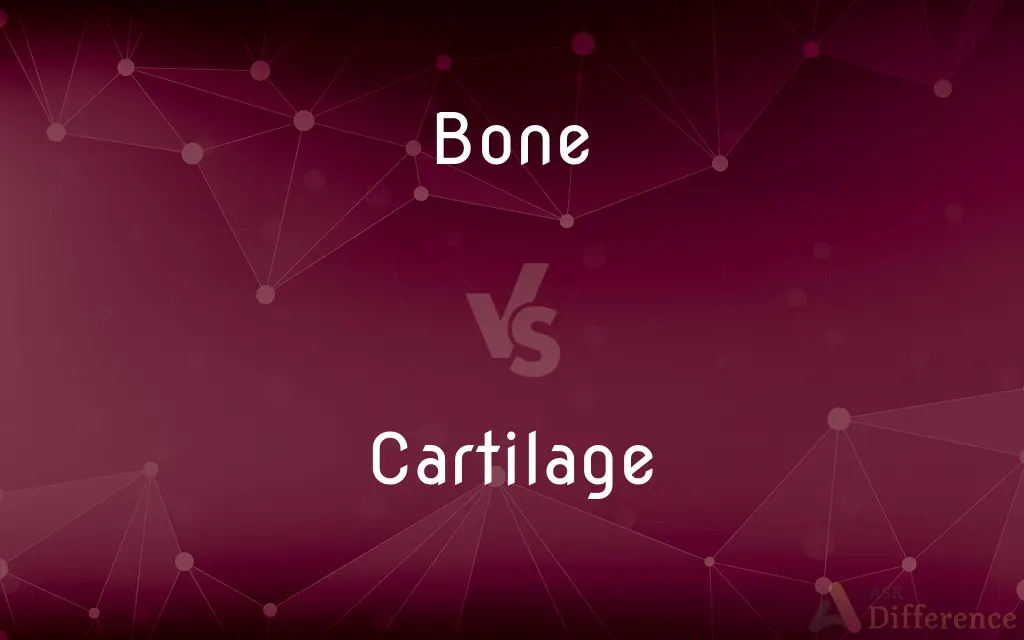Bone vs. Cartilage — What's the Difference?
By Fiza Rafique & Urooj Arif — Updated on March 24, 2024
Bones are rigid organs forming the skeleton, crucial for support and movement. Cartilage is a flexible tissue, providing cushioning and structural support where bones meet.

Difference Between Bone and Cartilage
Table of Contents
ADVERTISEMENT
Key Differences
Bones are hard, dense, and provide the primary structure and support for the body, enabling protection for vital organs and anchorage for muscles, facilitating movement. Whereas cartilage is a softer, more flexible tissue that cushions joints, supports various structures such as the ears and nose, and aids in the smooth movement of joints.
Bones undergo a continuous process of breakdown and renewal, a balance that maintains their strength and density. This process is influenced by nutritional and hormonal factors. On the other hand, cartilage growth and maintenance primarily occur through two processes: appositional growth (new cells and matrix are added on the surface) and interstitial growth (expansion from within), but this process significantly slows down after adolescence.
The composition of bones includes a matrix of collagen fibers and mineral deposits (mainly calcium and phosphate), giving them strength and rigidity. Cartilage, however, is composed of a gel-like matrix enriched with collagen and elastic fibers, providing it with flexibility and resistance to compressive forces.
In terms of function, bones act as levers that muscles act upon to produce movement, store minerals, and house bone marrow for white and red cell production. Cartilage functions to absorb shock, reduce friction between bones, and support soft tissues.
Comparison Chart
Composition
Collagen, calcium, phosphate
Collagen, elastic fibers, proteoglycans
ADVERTISEMENT
Texture
Hard and rigid
Soft and flexible
Function
Support, protection, movement, mineral storage, cell production
Cushioning, structural support, reducing friction
Compare with Definitions
Bone
Mineral Storage.
Bones store minerals like calcium and phosphate, crucial for various body functions.
Cartilage
Shock Absorption.
Cartilage in the knee absorbs shocks during running or jumping.
Bone
Support.
Bones provide the framework for the body, supporting the overall structure.
Cartilage
Cushioning.
Cartilage cushions joints, reducing stress during movement.
Bone
Movement.
Bones act as levers that muscles use to move the body.
Cartilage
Friction Reduction.
Cartilage reduces friction between bones, facilitating smooth joint movement.
Bone
Protection.
The skull bones protect the brain from injury.
Cartilage
Structural Support.
Cartilage provides structural support to the trachea, keeping airways open.
Bone
Former name for Annaba
Cartilage
Flexibility.
The flexibility of cartilage supports the ears and nose, maintaining their shape.
Bone
Remove the bones from (meat or fish) before cooking, serving, or selling
Ask your butcher to bone the turkey for you
Cartilage
Cartilage (cartilaginous tissue) is a resilient and smooth elastic tissue, rubber-like padding that covers and protects the ends of long bones at the joints and nerves, and is a structural component of the rib cage, the ear, the nose, the bronchial tubes, the intervertebral discs, and many other body components. It is not as hard and rigid as bone, but it is much stiffer and much less flexible than muscle.
Bone
Study (a subject) intensively, typically in preparation for something
She boned up on languages she had learned long ago
Cartilage
A tough, elastic, fibrous connective tissue that is a major constituent of the embryonic and young vertebrate skeleton and in most species is converted largely to bone with maturation. It is found in various parts of the human body, such as the joints, outer ear, and larynx.
Bone
The dense, semirigid, porous, calcified connective tissue forming the major portion of the skeleton of most vertebrates. It consists of a dense organic matrix and an inorganic, mineral component.
Cartilage
A usually translucent and somewhat elastic, dense, nonvascular connective tissue found in various forms in the larynx and respiratory tract, in structures such as the external ear, and in the articulating surfaces of joints. It composes most of the skeleton of vertebrate embryos, being replaced by bone during ossification in the higher vertebrates.
Bone
Any of numerous anatomically distinct structures making up the skeleton of a vertebrate animal. There are more than 200 different bones in the human body.
Cartilage
A particular structure made of cartilage.
Bone
A piece of bone.
Cartilage
A translucent, elastic tissue; gristle.
Bone
The skeleton.
Bone
The body
These old bones don't do much dancing anymore.
Bone
Mortal remains
His bones are buried up on the hill.
Bone
An animal structure or material, such as ivory, resembling bone.
Bone
A piece of whalebone or similar material used as a corset stay.
Bone
Bones(Informal) Dice.
Bone
Bones The fundamental plan or design, as of the plot of a book.
Bone
Bones Flat clappers made of bone or wood originally used by the end man in a minstrel show.
Bone
Bones (used with a sing. verb) The end man in a minstrel show.
Bone
To remove the bones from
Bone a fish.
Bone
To stiffen (a piece of clothing) with stays, as of whalebone.
Bone
(uncountable) A composite material consisting largely of calcium phosphate and collagen and making up the skeleton of most vertebrates.
Bone
(countable) Any of the components of an endoskeleton, made of bone.
Bone
A bone of a fish; a fishbone.
Bone
A bonefish.
Bone
One of the rigid parts of a corset that forms its frame, the boning, originally made of whalebone.
Bone
One of the fragments of bone held between the fingers of the hand and rattled together to keep time to music.
Bone
Anything made of bone, such as a bobbin for weaving bone lace.
Bone
(figurative) The framework of anything.
Bone
An off-white colour, like the colour of bone.
Bone
A dollar.
Bone
The wishbone formation.
Bone
A domino or dice.
Bone
(slang) A cannabis cigarette; a joint.
Bone
(figurative) A reward.
Bone
(slang) trombone
Bone
Of an off-white colour, like the colour of bone.
Bone
To prepare (meat, etc) by removing the bone or bones from.
Bone
To fertilize with bone.
Bone
To put whalebone into.
Bone
(civil engineering) To make level, using a particular procedure; to survey a level line.
Boning rod
Bone
To perform "bone pointing", a ritual that is intended to bring illness or even death to the victim.
Bone
(usually with "up") To study.
Bone up
Bone
To polish boots to a shiny finish.
Bone
To nag, especially for an unpaid debt.
Bone
To apprehend, steal.
Bone
To sight along an object or set of objects to check whether they are level or in line.
Bone
One of the pieces or parts of an animal skeleton; as, a rib or a thigh bone; a bone of the arm or leg; also, any fragment of bony substance. (pl.) The frame or skeleton of the body.
Bone
Anything made of bone, as a bobbin for weaving bone lace.
Bone
Two or four pieces of bone held between the fingers and struck together to make a kind of music.
Bone
Dice.
Bone
Whalebone; hence, a piece of whalebone or of steel for a corset.
Bone
Fig.: The framework of anything.
Bone
To withdraw bones from the flesh of, as in cookery.
Bone
To put whalebone into; as, to bone stays.
Bone
To fertilize with bone.
Bone
To steal; to take possession of.
Bone
To sight along an object or set of objects, to see if it or they be level or in line, as in carpentry, masonry, and surveying.
Joiners, etc., bone their work with two straight edges. W.
Bone
Rigid connective tissue that makes up the skeleton of vertebrates
Bone
The porous calcified substance from which bones are made
Bone
A shade of white the color of bleached bones
Bone
Study intensively, as before an exam;
I had to bone up on my Latin verbs before the final exam
Bone
Remove the bones from;
Bone the turkey before roasting it
Bone
Consisting of or made up of bone;
A bony substance
The bony framework of the body
Common Curiosities
Can cartilage become bone?
Yes, in a process called ossification, cartilage can be replaced by bone during growth or healing.
How does aging affect bones and cartilage?
Aging can lead to decreased bone density and cartilage degeneration, impacting mobility and joint function.
Why is cartilage important for joint function?
It provides cushioning and reduces friction, essential for pain-free and smooth joint movement.
How are bones and cartilage connected in the skeletal system?
Bones form the skeleton, while cartilage provides flexible support and cushioning at joints.
Can exercise benefit bones and cartilage?
Yes, exercise can improve bone density and joint function, supporting cartilage health.
How do bones and cartilage contribute to movement?
Bones act as levers for muscles, and cartilage reduces friction and cushions joints for smooth movement.
Is all cartilage the same?
No, there are three types: hyaline (most common, found in joints), elastic (ears, nose), and fibrocartilage (intervertebral discs).
Can diseases affect both bones and cartilage?
Yes, conditions like osteoarthritis affect cartilage, while osteoporosis affects bones.
Are there treatments to repair or replace damaged cartilage?
Treatments include physical therapy, injections, and surgeries, though complete cartilage repair remains challenging.
What is the main difference between bone and cartilage?
Bone is hard and supports the body, while cartilage is flexible and cushions joints.
How do nutritional factors affect bones and cartilage?
Proper nutrition supports bone density and health, while cartilage relies on diffusion from surrounding tissues due to its avascularity.
What roles do hormones play in bone and cartilage health?
Hormones regulate bone growth and density, and indirectly affect cartilage health by influencing overall joint health.
How does weight impact bones and cartilage?
Excessive weight can strain bones and wear down cartilage, leading to joint problems.
Share Your Discovery

Previous Comparison
Look vs. Watch
Next Comparison
Superintendent vs. ManagerAuthor Spotlight
Written by
Fiza RafiqueFiza Rafique is a skilled content writer at AskDifference.com, where she meticulously refines and enhances written pieces. Drawing from her vast editorial expertise, Fiza ensures clarity, accuracy, and precision in every article. Passionate about language, she continually seeks to elevate the quality of content for readers worldwide.
Co-written by
Urooj ArifUrooj is a skilled content writer at Ask Difference, known for her exceptional ability to simplify complex topics into engaging and informative content. With a passion for research and a flair for clear, concise writing, she consistently delivers articles that resonate with our diverse audience.














































